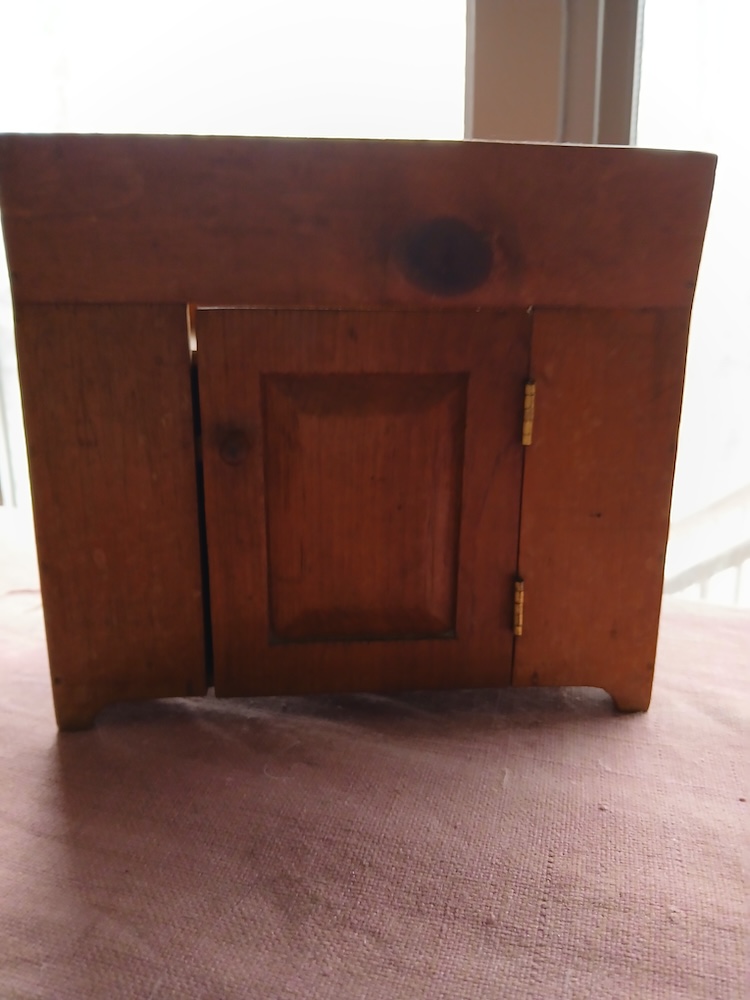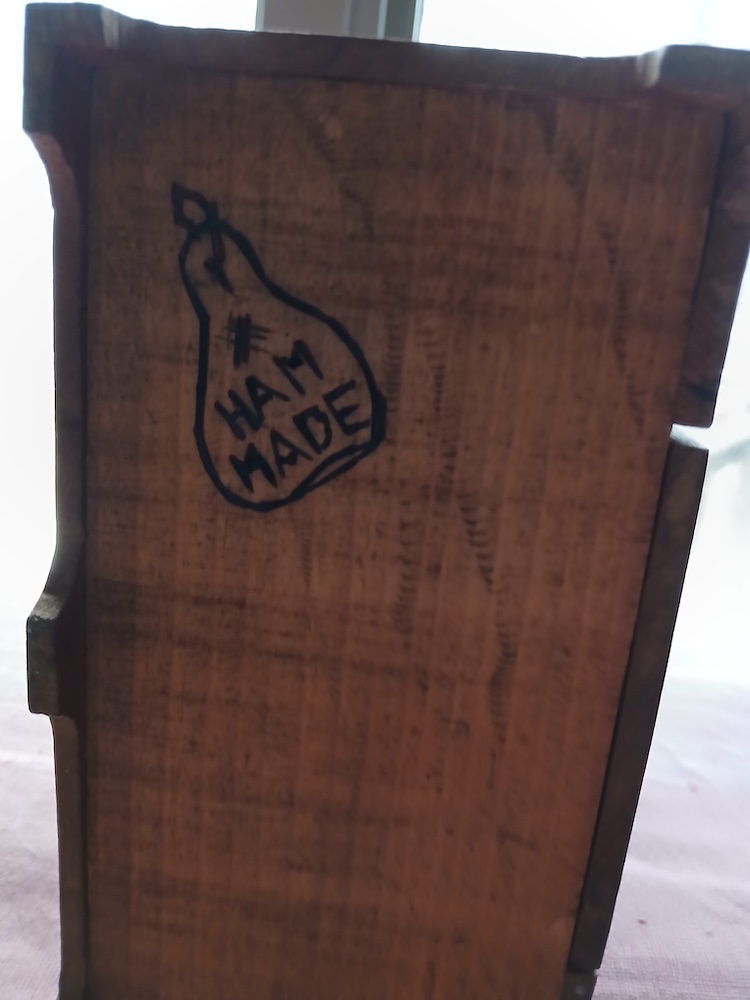Salesmen Samples

LW has a miniature pine dry sink, the type – though in larger scale – that was in use before indoor plumbing, and whose basin was typically zinc, soapstone, or copper lined. The dimensions are 8” (w) x 4.25” (d) x 7.5” (h), and the sink well is 2.5” deep. Hers is stamped with a burnt-in logo: “Ham Made.” The words sit in an outline of a ham-hock on the bottom of the piece, and I notice the plank that comprises the bottom has been hand planed, not cut with a modern circular saw.
All American households from Colonial times till the early to mid-20th century had a piece of furniture like this, in large scale, in the kitchen for washing and cleaning – more accessible than a bucket! The basin held a large pitcher and a wash basin for cleaning hands, vegetables, and dishes. Most of America gained access to indoor plumbing between 1900 and 1950, so the dry sink was a necessary piece of furniture.
LW’s little miniature is a salesman’s sample from the late 19th century, and like all salesman samples, these miniatures are typically 1:6 to 1:8 scale, hawked by turn-of-the-century travelling salesmen. Hers has the same hinging and hardware as the full-sized sink. Likely, when taken “on the road,” the salesman would have had a special little suitcase for this sample, which could be used as a platform display. Because LW’s has a company logo (as did all late 19th to early 20th century samples), it is not to be confused with a patent model or doll or children’s furniture. These can be of high value to collectors when they are most detailed, mechanically perfect, and intricate.
The male workforce in the U.S. clamored for jobs after the Civil War. Many burgeoning manufacturers of farm and household goods employed young men as traveling salesmen, armed with these miniature examples of their wares. Because of the growth of railroads during the War, rural farms, country stores, and distant homesteads were accessible. Itinerant salesmen took their miniature farm equipment, appliances, and furniture to ride the rails, putting the little models directly into potential buyer’s hands. The fully functional models charmed and convinced; the salesman closed the deal, and in a few months, the full-sized model was delivered.

Maxine Carter-Lome, for the Journal of Antiques writes: “Stoves, washing machines, working typewriters that can fit in the palm of your hand, shoes, a working grist mill, flexible flyer sleds, a brace and bit drill set, furniture, furnaces, stoves, ice boxes, toilets, farm equipment, working plows, reapers, hay-loaders; all got downsized.” (“Salesmen Samples: Artfully Small Examples of the Real Thing,” 2019.)
LW’s is not a children’s toy or doll furniture. It has a company logo (Ham Made). Salesmen’s furniture samples were made of the same wood and functionality as the real pieces, but for the wow factor, the miniatures were even more meticulously crafted. Selling a piece of furniture required convincing, because in turn of the century rural America, once a family purchased, they kept the piece for life.
The more intricate the miniature, the older the piece. After 1920s such miniatures were used by shop owners in promotional displays solely for marketing and branding, especially those miniatures that represented “newfangled” appliances such as electric/gas stoves, and mechanized washing machines. John Deere farm equipment company made promotional marketing toys that were not functional, for example.
My grandmother, born in 1900 in St. Louis, still had an “ice box” with real blocks of ice for refrigeration when I was a kid. She couldn’t be sold on a plug-in electric refrigerator. Resistance to the new? Yes. Just imagine a salesman demonstrating a tiny gas or electric stove to a woman who had prepared thousands of meals over a wood-fired oven. These demonstration miniatures were made of cast iron and enameled, fully functioning, with pots and brand names.
LW, I was not able to find anything about ‘Ham Made,’ as quaint as that branding is: in fact, it was burnt into the wood of the base with a custom branding iron. The origin of the term ‘branding’ goes back to 1500 when cattle began to be similarly branded. We know LW’s dry sink is no older than 1870 because registered trademarks (words, designs, shapes that are legal registered to a company) began in 1870 and became intellectual property. I mentioned the wood had been hand planed; the piece was hand-made, which would put it earlier than the mass-produced pieces of the 1920s. The value of LW’s dry sink is $250.







You must be logged in to post a comment.